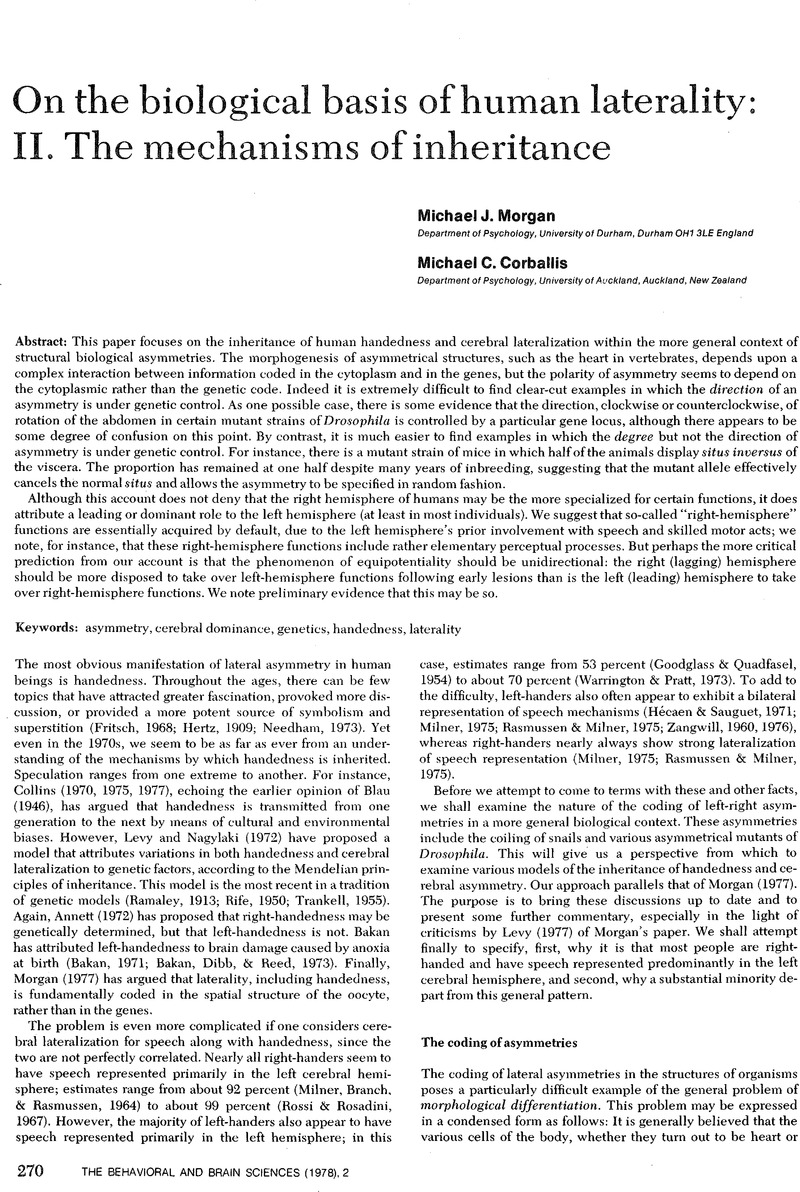No CrossRef data available.
Article contents
The nature and nurture of human laterality
Published online by Cambridge University Press: 04 February 2010
Abstract
An abstract is not available for this content so a preview has been provided. Please use the Get access link above for information on how to access this content.

- Type
- Open Peer Commentary
- Information
- Copyright
- Copyright © Cambridge University Press 1978
References
REFERENCES
Bader, R. S.Fluctuating asymmetry in the dentition of the house mouse. Growth. 29:291–300, 1965.Google ScholarPubMed
Bailit, H. L., Workman, P. L., Niswander, J. D., and MacClean, C. J.Dental asymmetry as an indicator of genetic and environmental stress in human populations. Human Biology. 42:626–38. 1970.Google ScholarPubMed
Frisancho, A. R.Developmental responses to high altitude hypoxia. American Journal of Physical Anthropology. 32:401–8. 1970.CrossRefGoogle ScholarPubMed
Galaburda, A. M., LeMay, M., Kemper, T. L., and Geschwind, N.Rightleft asymmetries in the brain. Science. 199:852–56. 1978.CrossRefGoogle ScholarPubMed
King, M. C., and Wilson, A. C.Evolution at two levels in humans and chimpanzees. Science. 188:107–16. 1975.CrossRefGoogle ScholarPubMed
Latimer, H. B., and Lowrance, E. W.Bilateral asymmetry in weight and in length of human bones. Anatomical Record. 152:217–24. 1965.CrossRefGoogle ScholarPubMed
Lowrance, E. W., and Latimer, H. B.Weights and linear measurements of 105 human skeletons from Asia. American Journal of Anatomy. 101:445–59. 1957.CrossRefGoogle ScholarPubMed
Montagu, M. F. A.Time, morphology, and neoteny in the evolution of man. American Anthropologist. 57:13–27. 1955.CrossRefGoogle Scholar
Perzigian, A. J.Fluctuating dental asymmetry: Variation among skeletal populations. American Journal of Physical Anthropology. 47:81–8. 1977.CrossRefGoogle ScholarPubMed
Potter, R. H., and Nance, W. E.A twin study of dental dimension I. Discordance, asymmetry, and mirror imagery. American Journal of Physical Anthropology, 44:391–96. 1976.CrossRefGoogle ScholarPubMed
Potter, R. H., Nance, W. E., Yu, P.-L., and Davis, W. B.A twin study of dental dimension II. Independent genetic determinants. American Journal of Physical Anthropology. 44:397–412. 1976.CrossRefGoogle ScholarPubMed
Schultz, A. H.Proportions, variability and asymmetry of the long bones of the limbs and the clavicles in man and apes. Human Biology. 9:281–328. 1937.Google Scholar
Siegel, M. I., and Doyle, W. J.The differential effects of prenatal and postnatal audiogenic stress on fluctuating dental asymmetry. Journal of Experimental Zoology. 191:211–14. 1975 a.CrossRefGoogle ScholarPubMed
Siegel, M. I., The effects of cold stress on fluctuating asymmetry on the dentition of the mouse. Journal of Experimental Zoology. 192:385–89. 1975 b.CrossRefGoogle Scholar
Siegel, M. I., and Smookler, H. H.Fluctuating dental asymmetry and audiogenic stress. Growth. 37:35–39. 1973.Google ScholarPubMed




